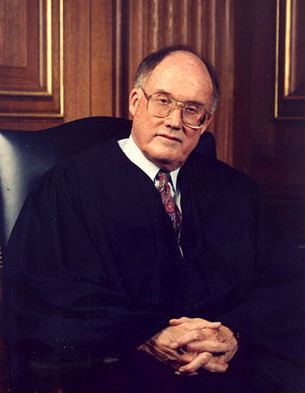Established 1986 Country United States | Dissolved 2005 No. of positions 9 | |
 | ||
Location Supreme Court BuildingWashington, D.C. | ||
The Rehnquist Court refers to the Supreme Court of the United States from 1986 to 2005, when William Rehnquist served as Chief Justice of the United States. Rehnquist succeeded Warren Burger as Chief Justice after the latter's retirement, and Rehnquist served as Chief Justice until his death in 2005, at which point John Roberts was nominated and confirmed as Rehnquist's replacement. The Rehnquist Court is generally considered to be more conservative than the preceding Burger Court and Warren Court. According to Jeffrey Rosen, Rehnquist combined an amiable nature with great organizational skill, and he "led a Court that put the brakes on some of the excesses of the Earl Warren era while keeping pace with the sentiments of a majority of the country." Biographer John Jenkins argued that Rehnquist politicized the Supreme Court and moved the court and the country to the right. Through its rulings, the Rehnquist Court often promoted a policy of New Federalism in which more power was given to the states at the expense of the federal government. The Rehnquist Court was also notable for its stability, as the same nine justices served together from 1994 to 2005, the longest such stretch in Supreme Court history.
Contents
Membership
Rehnquist joined the Court in 1972 after Richard Nixon appointed him as an Associate Justice, and Rehnquist remained in that position until Ronald Reagan elevated Rehnquist to the position of Chief Justice in 1986, when Warren Burger retired. Rehnquist's vacant Associate Justice seat was filled by Antonin Scalia. The Rehnquist Court thus began with Scalia and eight members of the Burger Court: Rehnquist, William Brennan, Byron White, Thurgood Marshall, Harry Blackmun, Lewis Powell, John Paul Stevens, and Sandra Day O'Connor. Powell retired in 1987; President Reagan's nomination of Robert Bork was defeated by the Senate, and his second nominee, Douglas Ginsburg, withdrew before a vote. Reagan's third nominee, Anthony Kennedy, was confirmed by the Senate. Brennan retired in 1990 and Marshall in 1991, giving President George H.W. Bush the opportunity to appoint Justices David Souter and Clarence Thomas. White retired in 1993 and Blackmun retired in 1994, and President Bill Clinton appointed Justices Ruth Bader Ginsburg and Stephen Breyer to replace them. Rehnquist, Stevens, O'Connor, Scalia, Kennedy, Souter, Thomas, Ginsburg, and Breyer served together from 1994 until Rehnquist's death in 2005. O'Connor, Souter, and Stevens all retired between 2006 and 2010 and Scalia died in 2016, but Kennedy, Thomas, Ginsburg, and Breyer remain on the Roberts Court as of 2016.
Chief Justice Associate Justice
Rulings of the Court
The Rehnquist Court issued several notable rulings touching on many aspects of American life. Landmark cases of the Rehnquist Court include:
Judicial philosophy
Rehnquist had often been a lone conservative dissenter during the Burger Court, but the appointments of O'Connor, Scalia, Kennedy, and, perhaps most importantly, Thomas, moved the court to the right. Rehnquist favored returning power to the states at the expense of the federal government, and he was joined by Justices O'Connor, Scalia, Kennedy, and Thomas in striking down federal laws, which the Rehnquist Court did more often than any previous court. These five justices formed a dominant conservative bloc, though Rehnquist was less committed to ideological purity than Scalia or Thomas, and Justices Kennedy and O'Connor often served as swing votes who would side with the more liberal justices. O'Connor's prominence as a swing vote led some to call it the "O'Connor Court," and she wrote several important opinions. Justice Stevens, the most senior associate justice during much of the Rehnquist Court, led the liberal bloc, which also included Justices Souter, Ginsburg, and Breyer. Stevens was often successful in winning over either or both of O'Connor and Kennedy in order to stymie the agenda of the court's conservative bloc. Of the nine justices who served from 1994-2005, seven had been appointed by Republican presidents, and the relative liberalism of some of those justices (particularly Stevens and Souter) frustrated many in the GOP.
